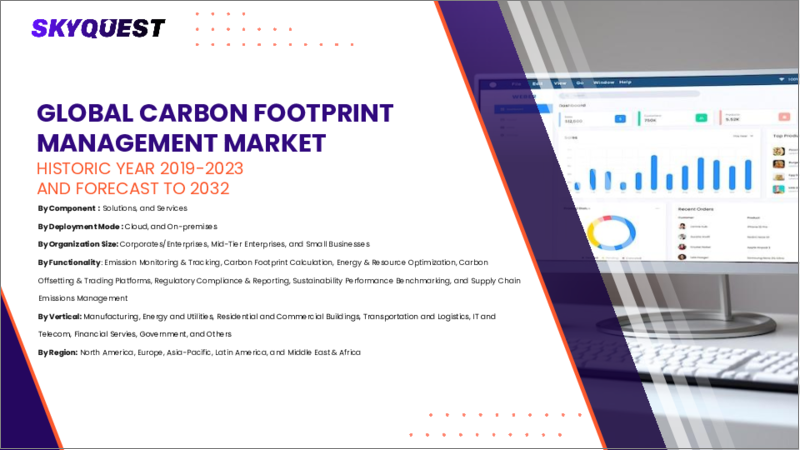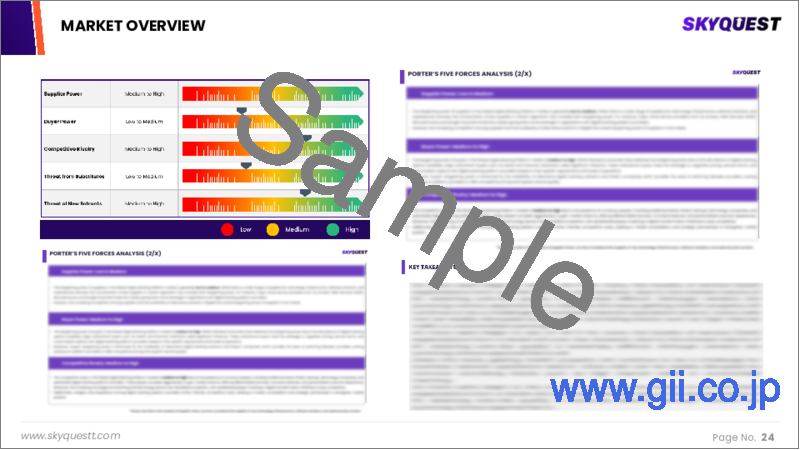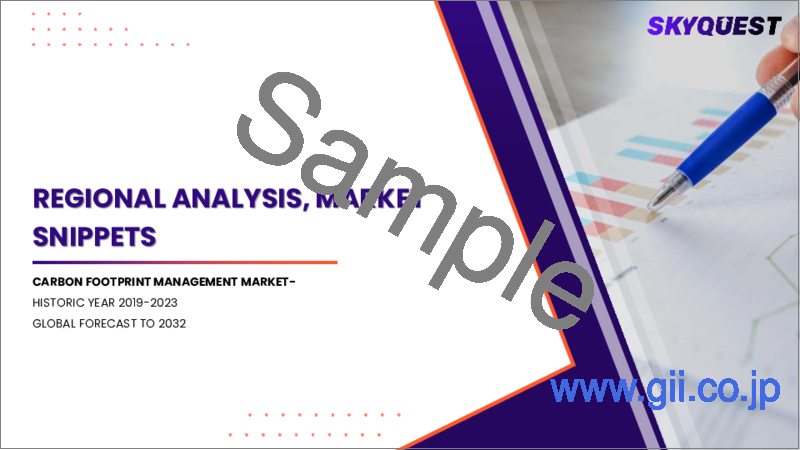|
|
市場調査レポート
商品コード
1722257
カーボンフットプリントの管理の市場規模、シェア、成長分析、コンポーネント別、展開モード別、組織規模別、業界別、地域別 - 産業予測 2025~2032年Carbon Footprint Management Market Size, Share, and Growth Analysis, By Component (Solution, Services), By Deployment Mode (Cloud, On-premises), By Organization, Vertical Industries, By Region, And Segment Forecast, 2025-2032 |
||||||
|
|||||||
| カーボンフットプリントの管理の市場規模、シェア、成長分析、コンポーネント別、展開モード別、組織規模別、業界別、地域別 - 産業予測 2025~2032年 |
|
出版日: 2025年05月02日
発行: SkyQuest
ページ情報: 英文 199 Pages
納期: 3~5営業日
|
全表示
- 概要
- 目次
カーボンフットプリント管理の世界市場規模は2023年に112億4,000万米ドルと評価され、2024年の123億5,000万米ドルから2032年には262億7,000万米ドルに成長し、予測期間(2025-2032年)のCAGRは9.89%で成長する見通しです。
世界のカーボンフットプリント管理市場は、持続可能なビジネス慣行への注目の高まり、企業責任規範の進化、排出量追跡技術の向上などに後押しされ、大幅な成長の瀬戸際にあります。都市化、規制圧力、透明性の高い炭素報告の需要といった要因が、市場拡大の鍵となります。データ収集と報告のための統合ソフトウエアを含む革新的技術は、企業のコンプライアンスと業務効率の向上に役立っています。しかし、規制環境の衝突、特にEUの厳格な炭素情報開示法と米国の貿易懸念は課題となっています。このような状況にもかかわらず、大西洋を越えた貿易は盛んであり、炭素管理部門は回復力を見せています。これは、2025年第1四半期にフォーチュン500社で炭素会計プラットフォームの採用が1.5%増加したことからも明らかであり、長期的な見通しが堅調であることを示しています。
目次
イントロダクション
- 調査の目的
- 調査範囲
- 定義
調査手法
- 情報調達
- 二次と一次データの方法
- 市場規模予測
- 市場の前提条件と制限
エグゼクティブサマリー
- 世界市場の見通し
- 供給と需要の動向分析
- セグメント別機会分析
市場力学と見通し
- 市場概要
- 市場規模
- 市場力学
- 促進要因と機会
- 抑制要因と課題
- ポーターの分析
主な市場の考察
- 重要成功要因
- 競合の程度
- 主な投資機会
- 市場エコシステム
- 市場の魅力指数(2024年)
- PESTEL分析
- マクロ経済指標
- バリューチェーン分析
- イノベーションマトリクス
- 技術分析
- 規制情勢
- ケーススタディ
カーボンフットプリント管理市場規模:コンポーネント別& CAGR(2025-2032)
- 市場概要
- ソリューション
- サービス
- コンサルティング
- 統合と展開
- サポートとメンテナンス
カーボンフットプリント管理市場規模:展開モード別& CAGR(2025-2032)
- 市場概要
- クラウド
- オンプレミス
カーボンフットプリント管理市場規模:組織規模別& CAGR(2025-2032)
- 市場概要
- 中小企業
- 大企業
カーボンフットプリント管理市場規模:業界別& CAGR(2025-2032)
- 市場概要
- 製造業
- エネルギー・公益事業業界
- 住宅・商業ビル
- 運輸・物流
- IT・通信
- その他
カーボンフットプリント管理市場規模:地域別& CAGR(2025-2032)
- 北米
- 米国
- カナダ
- 欧州
- ドイツ
- スペイン
- フランス
- 英国
- イタリア
- その他欧州地域
- アジア太平洋地域
- 中国
- インド
- 日本
- 韓国
- その他アジア太平洋地域
- ラテンアメリカ
- ブラジル
- メキシコ
- その他ラテンアメリカ地域
- 中東・アフリカ
- GCC諸国
- 南アフリカ
- その他中東・アフリカ
競合情報
- 上位5社の比較
- 主要企業の市場ポジショニング(2024年)
- 主な市場企業が採用した戦略
- 最近の市場動向
- 企業の市場シェア分析(2024年)
- 主要企業の企業プロファイル
- 企業の詳細
- 製品ポートフォリオ分析
- 企業のセグメント別シェア分析
- 収益の前年比比較(2022-2024年)
主要企業プロファイル
- IBM
- Schneider Electric
- Salesforce
- SAP
- ENGIE
- Enviance
- Isometrix
- ESP
- Dakota Software
- Accuvio
- ProcessMap
- Locus Technologies
- NativeEnergy
- EnergyCap
- Carbon Footprint Ltd
- EcoTrack
- Carbon Trust
- Envirosoft
- Intelex
- Enablon
結論と提言
Global Carbon Footprint Management Market size was valued at USD 11.24 billion in 2023 and is poised to grow from USD 12.35 billion in 2024 to USD 26.27 billion by 2032, growing at a CAGR of 9.89% during the forecast period (2025-2032).
The global Carbon Footprint Management market is on the brink of substantial growth, propelled by an increasing focus on sustainable business practices, evolving corporate responsibility norms, and improvements in emissions tracking technologies. Factors such as urbanization, regulatory pressures, and the demand for transparent carbon reporting are critical to market expansion. Innovative technologies, including integrated software for data collection and reporting, help businesses enhance compliance and operational efficiency. However, clashing regulatory environments, particularly the EU's strict carbon disclosure laws versus US trade concerns, present challenges. Despite this, transatlantic trade is thriving, and the carbon management sector is showing resilience, evidenced by a 1.5% growth in adoption of carbon accounting platforms among Fortune 500 firms in Q1 2025, indicating a robust long-term outlook.
Top-down and bottom-up approaches were used to estimate and validate the size of the Global Carbon Footprint Management market and to estimate the size of various other dependent submarkets. The research methodology used to estimate the market size includes the following details: The key players in the market were identified through secondary research, and their market shares in the respective regions were determined through primary and secondary research. This entire procedure includes the study of the annual and financial reports of the top market players and extensive interviews for key insights from industry leaders such as CEOs, VPs, directors, and marketing executives. All percentage shares split, and breakdowns were determined using secondary sources and verified through Primary sources. All possible parameters that affect the markets covered in this research study have been accounted for, viewed in extensive detail, verified through primary research, and analyzed to get the final quantitative and qualitative data.
Global Carbon Footprint Management Market Segments Analysis
The global Carbon Footprint Management market is segmented by component, deployment mode, organization size, vertical industry, and region. By component, the market is divided into solutions and services, with services further categorized into consulting, integration & deployment, and support & maintenance. Based on deployment mode, it is segmented into cloud and on-premises solutions. By organization size, the market is classified into SMEs and large enterprises. According to vertical industry, the market covers manufacturing, energy and utilities, residential and commercial buildings, transportation and logistics, IT and telecom, and others. Regionally, the market is analyzed across North America, Europe, Asia-Pacific, Middle East & Africa, and Latin America.
Driver of the Global Carbon Footprint Management Market
The global Carbon Footprint Management market is significantly influenced by the proliferation of multinational hotel chains, restaurant groups, and various hospitality businesses. With fast-food giants, upscale dining venues, and international hotel brands under mounting regulatory scrutiny and consumer expectations to lessen their environmental footprints, there is a heightened demand for effective carbon tracking, reporting, and mitigation solutions. To address these challenges, hospitality firms are increasingly investing in AI-powered carbon management platforms that facilitate the monitoring of energy use, supply chain emissions, and overall operational impacts. This commitment to sustainability and transparency is driving the rapid adoption of sophisticated carbon management technologies throughout the food service and accommodation industries.
Restraints in the Global Carbon Footprint Management Market
A primary constraint impacting the Global Carbon Footprint Management market is the substantial expense involved in implementing and maintaining sophisticated carbon management systems. These systems typically necessitate significant investments in specialized software, sensor networks, data integration platforms, and skilled personnel. For small- and medium-sized enterprises (SMEs), such high costs can be a considerable barrier that hampers their capacity to accurately monitor and mitigate emissions. Furthermore, the ongoing need for system upgrades and adherence to compliance regulations contributes to a prolonged financial strain, particularly in industries characterized by intricate or global supply chains.
Market Trends of the Global Carbon Footprint Management Market
The Global Carbon Footprint Management market is experiencing transformative growth driven by advancements in automation and artificial intelligence (AI), which are reshaping how organizations monitor and manage their emissions. In the short term, AI-powered solutions are improving real-time emissions tracking and predictive analytics, enhancing the accuracy and efficiency of carbon reporting. Companies can now navigate regulatory standards more effectively, alleviating the manual workload associated with compliance, while also aligning sustainability targets with operational cost optimization. This trend reflects a broader commitment to corporate responsibility and environmental stewardship, positioning innovative carbon management tools as essential for sustainable business practices in the future.
Table of Contents
Introduction
- Objectives of the Study
- Scope of the Report
- Definitions
Research Methodology
- Information Procurement
- Secondary & Primary Data Methods
- Market Size Estimation
- Market Assumptions & Limitations
Executive Summary
- Global Market Outlook
- Supply & Demand Trend Analysis
- Segmental Opportunity Analysis
Market Dynamics & Outlook
- Market Overview
- Market Size
- Market Dynamics
- Drivers & Opportunities
- Restraints & Challenges
- Porters Analysis
- Competitive rivalry
- Threat of substitute
- Bargaining power of buyers
- Threat of new entrants
- Bargaining power of suppliers
Key Market Insights
- Key Success Factors
- Degree of Competition
- Top Investment Pockets
- Market Ecosystem
- Market Attractiveness Index, 2024
- PESTEL Analysis
- Macro-Economic Indicators
- Value Chain Analysis
- Innovation Matrix
- Technology Analysis
- Regulatory Landscape
- Case Studies
Global Carbon Footprint Management Market Size by Component & CAGR (2025-2032)
- Market Overview
- Solutions
- Services
- Consulting
- Integration & Deployment
- Support & Maintenance
Global Carbon Footprint Management Market Size by Deployment Mode & CAGR (2025-2032)
- Market Overview
- Cloud
- On-premises
Global Carbon Footprint Management Market Size by Organization Size & CAGR (2025-2032)
- Market Overview
- SMEs
- Large Enterprises
Global Carbon Footprint Management Market Size by Vertical Industry & CAGR (2025-2032)
- Market Overview
- Manufacturing Industry
- Energy and Utilities Industry
- Residential and Commercial Buildings
- Transportation and Logistics
- IT and Telecom
- Others
Global Carbon Footprint Management Market Size & CAGR (2025-2032)
- North America (Component, Deployment Mode, Organization Size, Vertical Industry)
- US
- Canada
- Europe (Component, Deployment Mode, Organization Size, Vertical Industry)
- Germany
- Spain
- France
- UK
- Italy
- Rest of Europe
- Asia Pacific (Component, Deployment Mode, Organization Size, Vertical Industry)
- China
- India
- Japan
- South Korea
- Rest of Asia-Pacific
- Latin America (Component, Deployment Mode, Organization Size, Vertical Industry)
- Brazil
- Mexico
- Rest of Latin America
- Middle East & Africa (Component, Deployment Mode, Organization Size, Vertical Industry)
- GCC Countries
- South Africa
- Rest of Middle East & Africa
Competitive Intelligence
- Top 5 Player Comparison
- Market Positioning of Key Players, 2024
- Strategies Adopted by Key Market Players
- Recent Developments in the Market
- Company Market Share Analysis, 2024
- Company Profiles of All Key Players
- Company Details
- Product Portfolio Analysis
- Company's Segmental Share Analysis
- Revenue Y-O-Y Comparison (2022-2024)
Key Company Profiles
- IBM
- Company Overview
- Business Segment Overview
- Financial Updates
- Key Developments
- Schneider Electric
- Company Overview
- Business Segment Overview
- Financial Updates
- Key Developments
- Salesforce
- Company Overview
- Business Segment Overview
- Financial Updates
- Key Developments
- SAP
- Company Overview
- Business Segment Overview
- Financial Updates
- Key Developments
- ENGIE
- Company Overview
- Business Segment Overview
- Financial Updates
- Key Developments
- Enviance
- Company Overview
- Business Segment Overview
- Financial Updates
- Key Developments
- Isometrix
- Company Overview
- Business Segment Overview
- Financial Updates
- Key Developments
- ESP
- Company Overview
- Business Segment Overview
- Financial Updates
- Key Developments
- Dakota Software
- Company Overview
- Business Segment Overview
- Financial Updates
- Key Developments
- Accuvio
- Company Overview
- Business Segment Overview
- Financial Updates
- Key Developments
- ProcessMap
- Company Overview
- Business Segment Overview
- Financial Updates
- Key Developments
- Locus Technologies
- Company Overview
- Business Segment Overview
- Financial Updates
- Key Developments
- NativeEnergy
- Company Overview
- Business Segment Overview
- Financial Updates
- Key Developments
- EnergyCap
- Company Overview
- Business Segment Overview
- Financial Updates
- Key Developments
- Carbon Footprint Ltd
- Company Overview
- Business Segment Overview
- Financial Updates
- Key Developments
- EcoTrack
- Company Overview
- Business Segment Overview
- Financial Updates
- Key Developments
- Carbon Trust
- Company Overview
- Business Segment Overview
- Financial Updates
- Key Developments
- Envirosoft
- Company Overview
- Business Segment Overview
- Financial Updates
- Key Developments
- Intelex
- Company Overview
- Business Segment Overview
- Financial Updates
- Key Developments
- Enablon
- Company Overview
- Business Segment Overview
- Financial Updates
- Key Developments






